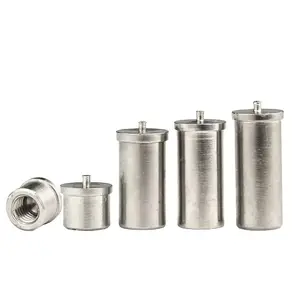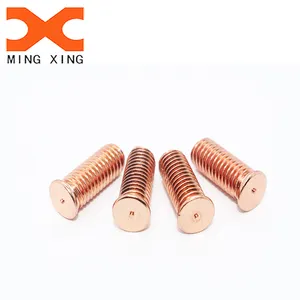Introduction
Embarking on a DIY project involving steel studs? This comprehensive guide will equip you with all the knowledge you need about steel stud screws. These essential tools, used in framing with steel studs, come in various types for different applications. They provide a secure and durable connection, ensuring the stability of your structure. From understanding their uses, choosing the right type for your project, to safety precautions and troubleshooting common issues, this guide covers it all. Let's dive in and explore the world of steel stud screws.
Understanding Steel Stud Screws
Steel stud screws are essential tools in framing with steel studs. They are used to join metal studs to tracks, fasten steel tracks to concrete, and attach electrical boxes to wood blocking. These screws are self-tapping, meaning they can tap their own hole as they are driven into it. They are used in conjunction with other tools like C-clamp locking pliers for clamping steel studs to tracks. Steel stud screws are also used in installing drywall and wood trim to underlying steel wall framing. They provide a secure and durable connection, ensuring the stability of the structure.
Types of Steel Stud Screws
Steel stud screws come in various types for different applications. Short self-drilling screws, like the #10 x 3/4″ Modified Truss Head or the 10 X 5/8″ Pancake Framer, are ideal for metal stud to stud connections. Hex head self-drilling screws are excellent for surfaces not being sheathed. Self-drilling drywall screws and sharp point drywall screws are used for connecting gypsum layers to metal studs. Sheathing screws are great for connecting plywood and other boards to metal studs. Trim screws are used for connecting low profile holes in wood or PVC to metal studs. Long bugle head screws and long modified truss head screws are used for attaching wide material to metal studs.
Benefits of Using Steel Stud Screws
Steel studs have gained popularity in construction, despite being more costly than traditional wood studs, due to their superior quality and strength. The challenge for builders has been finding the right fasteners. High-quality steel stud screws offer incredible holding power and adjustability. Mistakes are no longer an issue as they can be easily removed, readjusted, and re-installed. These screws offer enormous time-saving potential in light metal, drywall, or decking installation, with excellent holding power and the ability for subsequent screwing and readjustment without damaging the material.
Choosing the Right Steel Stud Screws for Your Project
Choosing the right steel stud screws for your project depends on several factors. The type of construction, materials being joined, and total thickness of the material in the connection are key considerations. For instance, bugle-head screws are ideal for interior walls with gypsum board, while hex-head screws are used for framing walls. When fastening steel to steel, the thickness of the members determines the screw choice. Self-piercing screws work best with thinner material, while self-drilling screws are suitable for thicker materials. Always refer to manufacturers' charts for final fastener selection.
How to Use Steel Stud Screws: Step-by-Step Guide
When working with steel studs, it's crucial to use the right screws. For hanging drywall, fine drywall screws are ideal for 20- to 25-gauge steel studs. For 12- to 20-gauge studs, use self-drilling drywall screws. Wood trim requires pilot holes and 1 1/2-inch self-drilling trim screws. In new construction, pan head framing screws are preferred for attaching steel studs to the metal channel. For attaching steel stud channel to concrete flooring, concrete screws are best. Remember, the correct choice of screw is paramount for proper strength.
Safety Precautions When Using Steel Stud Screws
When working with steel stud screws, safety is paramount. Always protect your hands with heavy-duty gloves when cutting steel studs. Be cautious of the sharp edges of steel studs and tracks. It's recommended to wear safety glasses, a dust mask, long sleeves, and hearing protection when cutting steel studs with a circular saw due to the sparks, smoke, and noise. Also, be mindful of electrical cords draped over sharp tracks to avoid cutting them. Lastly, remember that steel studs and tracks are sharp, so wearing gloves is advisable.
Troubleshooting Common Issues
When using steel stud screws, common issues can arise such as poor fastening, incorrect alignment, and inadequate supporting structures. Poor fastening can lead to instability and structural weaknesses. Incorrect alignment can result in uneven surfaces and warped walls. Inadequate supporting structures can cause structural instability and even collapse. To overcome these issues, ensure proper spacing and use of fasteners, accurate alignment using a level and plumb line, and adherence to building codes for proper framing and structural support.
Maintaining and Storing Steel Stud Screws
Proper maintenance and storage of steel stud screws can extend their lifespan and ensure their optimal performance. Keep them in a dry, cool place to prevent rusting. Regularly check for any signs of wear and tear and replace any damaged screws promptly to maintain the integrity of your structures.
Conclusion
In conclusion, steel stud screws are an indispensable tool in any DIY project involving steel studs. Their versatility, strength, and durability make them ideal for various applications. Choosing the right screw type for your project is crucial, as is adhering to safety precautions. Troubleshooting common issues and maintaining your screws properly will ensure the longevity and stability of your structure. With this guide, you're now well-equipped to tackle your next project with confidence and expertise.

































 浙公网安备 33010002000092号
浙公网安备 33010002000092号 浙B2-20120091-4
浙B2-20120091-4